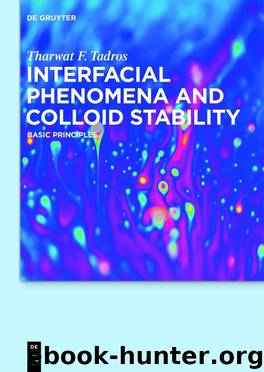Interfacial Phenomena and Colloid Stability: Basic Principles by Tadros Tharwat F

Author:Tadros, Tharwat F. [Tadros, Tharwat F.]
Language: eng
Format: epub
Publisher: De Gruyter
Published: 2015-05-04T16:00:00+00:00
8.6 Theoretical treatment of surfactant adsorption
Klimenko [17, 18] developed a theoretical model for the three stages of adsorption of nonionic surfactants. In the first stage (flat orientation) a modified Langmuir adsorption equation was used,
(8.18)
where c2 is the equilibrium concentration of surfactant in bulk solution, Γ2 is the surface excess concentration at C2 , is the surface excess at the cmc, Ka is a constant, a1 and are the effective cross-sectional areas of the solvent and adsorbate molecules in the surface, and is an adsorbate surface activity coefficient. The term in the square bracket is a type of surface “concentration” which is defined as the ratio of numbers of adsorbed surfactant molecules to the number of solvent molecules in the equilibrium interfacial layer. The constant Ka allows for adsorbate-adsorbent interactions and is therefore related to the energy of adsorption at infinite dilution. The adsorbate surface activity coefficient accounts for the adsorbate-adsorbate interaction and it is assumed to have the following dependence on Γ2 in the first stage of adsorption,
Download
This site does not store any files on its server. We only index and link to content provided by other sites. Please contact the content providers to delete copyright contents if any and email us, we'll remove relevant links or contents immediately.
Alchemy and Alchemists by C. J. S. Thompson(3301)
The Elements by Theodore Gray(2856)
The Club by A.L. Brooks(2756)
How to Make Your Own Soap by Sally Hornsey(2747)
Drugs Unlimited by Mike Power(2488)
Wheels of Life by Anodea Judith(1923)
Cracking the Sat French Subject Test, 2013-2014 Edition by The Princeton Review(1769)
Perfume by Jean-Claude Ellena(1742)
The Flavor Matrix by James Briscione(1716)
Cracking the LSAT, 2012 Edition by Princeton Review(1698)
The Cosmic Machine: The Science That Runs Our Universe and the Story Behind It by Scott Bembenek(1693)
MCAT Physics and Math Review by Princeton Review(1571)
1000 Multiple-Choice Questions in Organic Chemistry by Organic Chemistry Academy(1568)
The Thing Around Your Neck by Chimamanda Ngozi Adichie(1490)
Cracking the SAT Premium Edition with 6 Practice Tests, 2017 by Princeton Review(1481)
Handbook of Modern Sensors by Jacob Fraden(1481)
Synchrotron Light Sources and Free-Electron Lasers by Eberhard J. Jaeschke Shaukat Khan Jochen R. Schneider & Jerome B. Hastings(1461)
A is for Arsenic: The Poisons of Agatha Christie (Bloomsbury Sigma) by Kathryn Harkup(1458)
Harry Potter All Books: 8 Books by J.k.rowling(1438)
